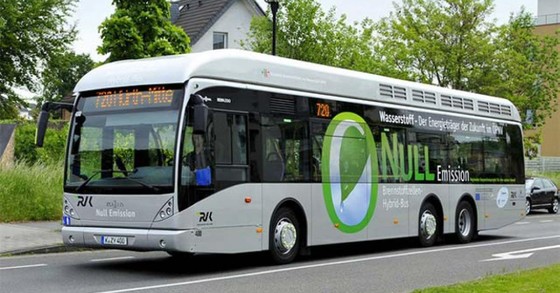SGGP
The European Business Observatory has just published an investigative report revealing that lobbyists for EU and US oil companies used false claims about hydrogen production to access billions of dollars in government subsidies, while also helping these companies protect their profits.
 |
| Electronic fuel buses in Germany |
Safe exit
In May 2022, leaders from the oil and energy industries were invited by German Education and Research Minister Bettina Stark-Watzinger to speak with bankers, investors, and politicians about the lucrative green gas, hydrogen. Germany's embrace of green hydrogen was a major victory for the hydrogen lobby. A recent report by the European Enterprise Observatory shows that lobbyists successfully shaped Germany's position on the issue through significant advertising spending. The chairman of the energy lobbying group, the German Energy and Industry Association (BDEW), stated that BDEW member companies are responsible for 90% of the country's fossil gas sales.
In negotiations to finalize the phasing out of internal combustion engine vehicles by 2035, Germany refused to sign until an alternative was in place: vehicles that could be sold after 2035 if powered by electronic fuel (eFuel). Germany's eFuel supply comes primarily from automakers within the eFuel Alliance, who loudly proclaim their goal is for eFuel to gain political and regulatory approval as a significant contribution to climate sustainability. Over 100 German companies – many linked to fossil fuels and other polluting industries – have been identified as key players in the green hydrogen value chain. As governments set emission reduction and decarbonization targets for 2050 as part of their climate change agendas, posing risks to fossil fuels, businesses have turned to hydrogen as a way to delay climate action. Hydrogen has also become a silver bullet for EU and German policymakers. Germany is set to become Europe's largest hydrogen importer, with an estimated share of up to 70% of combined EU and UK imports in the future. The EU's REPowerEU green hydrogen plan aims to import 20 million tonnes of green hydrogen by 2030, half through domestic production and half through imports. However, this is unrealistic as less than 0.04 million tonnes of green hydrogen were produced globally in 2021.
Americans were ahead of their time when, in 1977, Exxon Corporation was the first to accurately identify hydrogen production as a cause of catastrophic future climate change. However, since then, Exxon has been highly successful in concealing the truth from investors and governments worldwide. According to two experts, Alex Grant, President of Jade Cove Partners (San Francisco, USA), and Paul Martin, a chemical process development expert (Toronto, Canada), Exxon and other fossil fuel companies have waged a multi-generational information war to sow fear and doubt about climate science and new energy technologies in order to increase market share for their hydrocarbon products, boost profits, and reduce costs.
enormous carbon footprint
Similar to the scenario used by the tobacco industry to block tobacco regulations, the hype surrounding hydrogen masks the reality that 99% of hydrogen produced globally today is “gray” hydrogen made from fossil fuels, with annual CO2 emissions exceeding those of Germany as a whole. Green hydrogen is touted as a low-carbon alternative. Green hydrogen is made from natural gas, extracted from gas fields and then refined by removing carbon dioxide, which must be stored back underground. This process typically accounts for 10-15% of greenhouse gas emissions, accumulating even more as production increases. Producing both gray and green hydrogen is significantly more expensive than conventional fuels. The report warns that this is a fossil fuel product with emissions captured through carbon capture and storage, a flawed, risky, and costly technology.
Former British Prime Minister Boris Johnson once placed hydrogen at the heart of his Net Zero PR campaign, stating that the government would invest up to £500 million in new production facilities and testing the use of hydrogen for heating homes. He spoke of building a hydrogen town and creating 5GW of low-carbon hydrogen by 2030. But Johnson seems to have forgotten to mention the existing hydrogen production industry, which produces around 115 million tonnes of hydrogen annually and releases 830 million tonnes of CO2 into the atmosphere. 830 million tonnes of CO2 per year, or 2% of total global greenhouse gas emissions. That's four-fifths of the emissions from the aviation industry; more than double the emissions of the entire UK economy. And over 99% of it is "grey hydrogen"—meaning it's extracted from natural gas, coal, or oil.
The International Energy Agency (IEA) has mapped hydrogen use as follows: 30% of total global hydrogen use – equivalent to 38 million tonnes/year – is in refineries. Most of this is produced locally, primarily from natural gas. Hydrogen is used in chemical processes to remove sulfur and other impurities from crude oil. Hydrogen used in refineries generates approximately 230 million tonnes of CO2 emissions per year – slightly more than the entire economy of Singapore, and slightly less than that of France. Another 27% of hydrogen is embedded in chemicals to produce ammonia; smaller amounts are used in the production of explosives, synthetic fibers, and other chemical products. The next use of hydrogen, accounting for 11% of the total, is methanol production; about 3% of the world's hydrogen is used in the direct iron reduction process for steel production…
“Electronic fuels, based on hydrogen and CO2, are very inefficient. With an estimated energy efficiency of 16% compared to 72% in electric vehicles, they are not part of the climate solution,” the report emphasizes.
Source







![[Photo] Prime Minister Pham Minh Chinh attends the Conference on the Implementation of Tasks for 2026 of the Industry and Trade Sector](/_next/image?url=https%3A%2F%2Fvphoto.vietnam.vn%2Fthumb%2F1200x675%2Fvietnam%2Fresource%2FIMAGE%2F2025%2F12%2F19%2F1766159500458_ndo_br_shared31-jpg.webp&w=3840&q=75)































































































Comment (0)